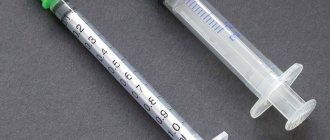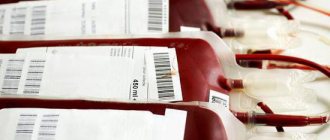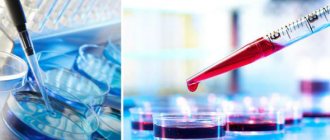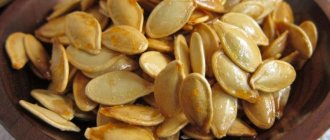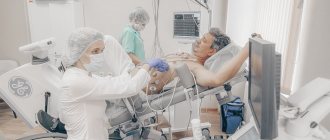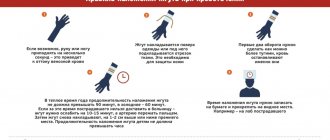A study of blood from a vein will be informative for diseases of any organs. This biological fluid consists of plasma and cells (formed elements), the concentration of which varies depending on the state of health. Thus, inflammatory processes are accompanied by changes in blood parameters, and a characteristic clinical picture is observed with helminth infestations, acute and chronic pathologies of internal organs. If capillary blood is suitable only for general (clinical) analysis and some rapid tests, then venous blood is used, including for biochemical studies. Before donating, it is important to understand what blood from a vein shows, why the diagnosis is carried out and how to correctly determine its results.
Vacuum systems: equipment and purpose
A standard vacuum blood collection system consists of three components:
- Double-edged needle for venipuncture.
- Holder (adapter) for fixing the needle.
- Vacuum tube with reagent.
All components of the system are intended for one-time use only.
The principle of operation of the system: under the influence of a vacuum, blood is drawn into a test tube with a reagent and immediately mixed with it. A certain amount of reagent and the volume of blood required for the study provide the exact ratio of components for the study.
Factor No. 6. “Easy”
It is recommended that blood collection be done early in the morning after a 12-hour fast and no changes in diet for 24 hours. The patient should go to bed at the usual time the day before and get up no later than an hour before blood collection (baseline).
How it affects: Important for hemoglobin levels. Sample turbidity, even slight, distorts photometric data. Hemoglobin is likely to be elevated, which will affect the control of anemic patients. The MCHC indicator can serve as a control over the correctness of hemoglobin measurement.
Needles
The wall of the blood collection needle is ultra-thin, which increases its internal lumen. The outer and inner surface of the needle wall is coated with silicone to reduce trauma to the patient and improve free blood flow. The V-shaped laser sharpening of the cut facilitates painless, smooth entry of the needle into the vein through the skin.
On the tip side for piercing the test tube, the needle is equipped with a thread and a protective rubber membrane. The needles are sealed in two plastic cases (caps) and sealed with a label to prevent their reuse. The color coding of the caps helps in choosing the needle diameter.
How to donate blood correctly?
It is recommended to donate venous blood in the morning on an empty stomach. You should not eat food for 8 hours, and abstain from drinking alcohol and medications for several days. If there is a need to take medications on a regular basis, you must notify your doctor. On the eve of the analysis, you should not undergo active physical activity, it is advisable to ensure yourself peace. The timing of the analysis depends on the laboratory. If necessary, results can be ready within a few hours. In most cases, the patient can pick them up the next day, and the analysis is deciphered by the attending physician.
Taking venous blood is indicated for suspicion of many diseases, as well as during routine examinations. It is not recommended to take it without prior preparation - this may affect the test results.
Preparation for the procedure
- Check that all necessary equipment is available.
- Check the expiration date and integrity of the vacuum system packaging.
- Check the expiration date and tightness of antiseptic wipes.
- Take the needle by the long colored cap in one hand, and with the other hand remove the short colored cap from the side of the rubber membrane.
- Insert the freed end of the needle with the rubber membrane into the holder and screw it until it stops.
- Place the needle and holder on the tray.
- Prepare the necessary test tubes in sufficient quantity.
- Wear sterile gloves.
Why do they take blood from a vein?
In recent years, modern laboratories have used only venous blood for research. Previously, capillary blood from the ring finger was used for some tests, for example, in the case of a general blood test. With this method of collecting biomaterial, microthrombi often formed, which made it difficult to calculate the studied parameters.
Venous blood collection using vacuum systems
Taking blood from a vein provides comprehensive information about the state of health and allows you to prescribe the necessary instrumental examination methods to clarify the diagnosis. The most frequently used clinical methods are those that reveal the nature of the pathological process, allow the treatment of the disease to be adjusted, and are also used for screening and preventive examinations.
- A general blood test reveals the cellular composition of the blood and ESR. Prescribed for the diagnosis of inflammatory diseases, infections, blood pathologies. Refers to a mandatory examination method during annual medical examinations.
- Blood biochemistry determines the main biological indicators (glucose, proteins, electrolytes, enzymes, lipids) and indicates the pathology of the liver, heart, blood vessels, and the development of oncology.
- Hormonal background studies the level of hormones and the function of the endocrine, digestive system, and metabolism.
- The immunological status determines the state of cellular and humoral immunity, the development of allergic reactions.
Donating blood from a vein is required when diagnosing any disease. Laboratory tests are safe and painless methods for identifying pathological processes in the body.
Carrying out manipulation
- Ask the patient to make room for the upcoming venipuncture (most often the elbow, possibly the forearm, the back of the hand).
- Place an oilcloth pillow under the venipuncture site.
- Apply a tourniquet 7-10 cm above the venipuncture site on top of clothing or a diaper. The tourniquet is applied so that the pulsation of the nearby artery is maintained.
- Ask the patient to make a fist.
- Inspect and palpate the vein for venipuncture.
- Treat the venipuncture site with antiseptic wipes.
- Hold the vacuum system in one hand and remove the protective cap from the needle with the other hand.
- With your free hand, stretch the skin below the venipuncture site at a distance of 4-5 cm to secure the vein.
- Puncture the vein at an angle of 10-15º, insert the needle along the vein no more than 1/2 of the length.
- Take the test tube and insert it into the holder until it stops.
- Once the blood begins to flow into the tube, remove or loosen the tourniquet.
- Ask the patient to unclench his fist.
- Draw the required amount of blood into a test tube.
- Remove the tube from the holder when blood stops flowing into it.
- Carefully invert the tube several times to mix the blood with the filler. Do not shake the test tube!
- Place the test tube in a rack.
- If necessary, connect the next test tube to the system and repeat all steps.
- Draw the required amount of blood into all tubes.
- Apply a sterile napkin with an antiseptic to the venipuncture site and remove the needle.
- Ask the patient to press down on the tissue with his free hand.
- Place the needle in a sharps container - Class B waste.
- Place the holder in another container for collecting Class B waste.
- Apply a pressure bandage or adhesive bandage over the napkin.
- Inquire about the patient’s well-being and make sure everything is okay.
- Label the tubes containing the collected blood samples with the patient's last name and initials.
- Place used consumables in Class A and B waste containers.
- Make the necessary notes in medical documentation on paper and electronic media.
- Send the collected material with accompanying documents to the laboratory.
Possible errors when using vacuum tubes
| Problem | Possible reasons | Solution |
| Blood does not flow into the tube after connecting to the holder | The needle did not enter the vein | In all of these cases, it is necessary to carefully adjust the position of the needle. There is no need to disconnect the tube from the holder if there is no need to remove the needle and under the skin. |
| The tip of the needle rests against the venous wall | ||
| The vein is pierced through | ||
| The blood in the test tube was received in less quantity than required for the analysis. | The venous vessel collapsed due to low pressure | It is necessary to disconnect the tube from the holder and wait a while until the vein is filled again |
| The system needs to be replaced and the procedure repeated | Air got into the test tube |
You can order high-quality laboratory consumables. When collecting blood using a vacuum system, follow the algorithm. This will ensure the safety of the procedure and the reliability of the research results.
Factor No. 9. Drugs/medicines
Medicines and their metabolites can change OAC parameters due to a physicochemical effect on the procedure or due to their interaction with the device and reagents.
If the patient takes medications, especially in large dosages, such as antipyretics, analgesics, antibiotics, antispasmodics, it is necessary to take into account the effect of their metabolites on blood pH. The more medications a patient takes immediately before donating blood, the higher the likelihood of distorting the result. In addition, the presence of active metabolites significantly reduces the standardized time available for analysis. For UAC, the optimal execution time is considered to be 2 hours, within which the material remains as stable as possible. For CBC calculated on a hematology analyzer, this time is 6 hours. For OAC, if the patient has taken a large amount of medications, the time can be reduced to 30 minutes for any type of study.
Life-saving medications should be taken as usual! Their presence in the blood is the basic state from which dynamics are assessed.
How it affects: When a blood test with drug metabolites is carried out later than the established time interval, the volume of leukocytes changes, the volume of erythrocytes increases, which leads to errors in the morphological differentiation of leukocytes and calculated erythrocyte indices.
The platelet count when taking antiplatelet agents (NSAIDs, acetylsalicylic acid) may be underestimated by the analyzer. Falsely elevated MCV index can occur with hyperglycemia and ketoacidosis due to plasma hyperosmolarity.
If there is an excess of medicinal metabolites in the blood, the morphological characteristics of neutrophils and monocytes will change, the volumes will decrease and the form of other elements of the blood test will change. In practically healthy people, changing the basic parameters of cells will not cause significant changes in the count. The state of pathological elements in severe diseases cannot be standardized; the only requirement is to minimize the time before starting the analysis.
Factor No. 8. “Casual” smoking
A mandatory point that must be taken into account by the clinician is smoking. The condition where the patient is a chronic smoker is regarded as the basic condition. If a person was forced to quit smoking and this fact is unknown to the attending physician, then the number of erythrocytes, platelets and hematocrit are subject to changes in the CBC, and the changes can be of a different nature. Particular attention should be paid to adolescents - a group of patients who smoke rarely and irregularly.
How it affects: “Sudden” smoking before taking a blood test can overestimate the number of red blood cells by 10%.
General blood analysis. Table of reference values
| Index | Patient gender | Norm |
| Hemoglobin | Men Women | 130-170 g/l 120-150 g/l |
| Red blood cells | Men Women | 4.0-5.0 1012/l 3.5-4.7 1012/l |
| Leukocytes | — | 4.0-9.0×109/l |
| Hematocrit (the ratio of the volume of plasma and cellular elements of blood) | Men Women | 42-50% 38-47% |
| Average red blood cell volume | — | 86-98 µm3 |
| Leukocyte formula | — | Neutrophils:
Monocytes: 3-11% Eosinophils: 0.5-5% Basophils: 0-1% |
| Platelet count | — | 180-320·109/l |
| Erythrocyte sedimentation rate (ESR) | Men Women | 3 - 10 mm/h 5 - 15 mm/h |
Factor No. 7. I worked hard and got nervous
Physical activity, especially intense or unusual for the patient, can increase the CBC indicators, namely the number of red blood cells, white blood cells and hematocrit. Psycho-emotional stress will also affect the number of leukocytes. In this case, chronic severe stress is considered as a basic pathological condition, and acute stress is taken into account, for example, with sensitivity to service in municipal institutions.
How it affects: For biological variation, the most sensitive indicator is leukocytes. Physical overexertion in combination with deviations in the time of sampling can change the number of leukocytes by ± 4 × 109/l.
